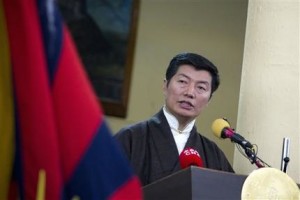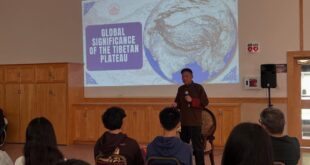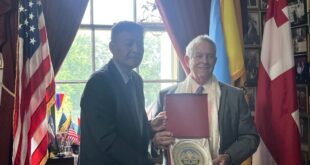On behalf of the 6 million Tibetans, the Kashag pays its deep reverence and humble respects to His Holiness the Great XIV Dalai Lama of Tibet on this special occasion of the 24th Anniversary of the conferment of the Nobel Peace Prize to His Holiness the Dalai Lama.
The Kashag also extends its warmest greetings to fellow Tibetans, friends and well-wishers all over the world.
On this day in 1989, His Holiness the Dalai Lama was awarded the Nobel Peace Prize for his consistent resistance to the use of violence in his people’s struggle for basic freedoms. The Nobel Peace Prize to His Holiness the Dalai Lama catapulted the Tibetan struggle to greater international visibility. His Holiness the Dalai Lama’s global stature directly and positively impacted on the image of the Tibetan people and fundamentally strengthened the Tibetan cause. Tibet became synonymous with non-violence and justice.

This day is also observed as World Human Rights Day, to celebrate the proclamation and adoption of the Universal Declaration of Human Rights by the United Nations in 1948 as the common standard to measure the freedoms to which all peoples and nations should live.
Unfortunately, even after 65 years of proclamation there is not much for Tibetans to celebrate given the deteriorating human rights condition in Tibet.
China continues to negate the principle of the universality of human rights by violating the provisions of the Universal Declaration of Human Rights. Tibet is still under occupation. It continues to suffer from political repression, economic marginalisation, social discrimination, environmental destruction and cultural assimilation. Worst is the mass Chinese migration to Tibet which has turned Tibetans into second-class citizens in their own homeland.
Living under such a repressive environment, with no space for conventional methods of protest, Tibetans from all walks of life are forced to take drastic measures to express their outrage and despair. Just a week ago, Mr. Kunchok Tsetan, only 30 years old, self-immolated and died. Despite our repeated appeals not to do so, 123 Tibetans have self-immolated in Tibet since 2009. 123 is neither simply a number nor a list of names. They are human beings just like any one of us who will wish to live a complete life, if given a choice. China cannot deny the blatant human rights violations which are the causes for the self-immolations.
Recently in Driru, Nagchu, Tibetans refused to hoist the Chinese national flag. They were shot at and 4 of them were killed. Many were detained. The situation in the area continues to remain tense.
Instead of seeing His Holiness the Dalai Lama as the solution, he is labeled an arch enemy. Chen Quanguo, the Party Secretary of the so-called Tibet Autonomous Region (TAR), threatened to silence His Holiness the Dalai Lama’s voice and ban his own people inside Tibet from hearing his message. Similarly, the voice of their own Nobel Peace Prize winner, Liu Xiaobo, is silenced as he is currently imprisoned in China.
The deteriorating human rights situation inside Tibet is being criticised and castigated in the US State Department Human Rights Report, Amnesty International Report and Human Rights Watch Report. The Freedom House ranked Tibet among the ‘worst of the worst’ in civil rights and political liberty in its Freedom in the World Report 2013.
In the recent United Nations Human Rights Council’s Universal Periodic Review of China, 12 nations including Japan, Australia, Iceland and Canada expressed their concern over China’s human rights violations. Among others, New Zealand called on China to resume two-way dialogue to resolve the issue of Tibet.
The Central Tibetan Administration (CTA) remains committed to the Middle-Way Approach and reiterates that dialogue is the most realistic approach and the only way to find a mutually beneficial solution to the Tibet issue. The Middle-Way Approach neither seeks separation from the People’s Republic of China nor “high degree of autonomy”, but Genuine Autonomy for all Tibetan people under a single administration. This is consistent with both the National Regional Autonomy Law and the Constitution of the People’s Republic of China.
The CTA does not use the term “Greater Tibet.” The three traditional provinces of U-Tsang, Kham and Amdo have always been essential parts of Tibet that covers the entire Tibetan plateau. They share not just the same geography and topography but also culture, language and religion. Division of Tibet into several provinces of China is a clear violation of Chinese laws and of Article 4 of the Constitution which recognises the right of minority nationalities to practice regional autonomy “in the areas of where they live in concentrated communities” and to “set up organ of self government for the exercise of power of autonomy.” 99% Uyghurs live in Xinjiang Uyghur Autonomous Region and 95% of Zhuangs live in Guangxi Zhuang Autonomous Region. Tibetans living in one concentrated community are divided into different provinces with less than 50% in the TAR while the majority is incorporated into neighbouring Chinese provinces as Tibetan autonomous prefectures and counties.
Tibet constituting one-fourth of China is not a recent political creation but a natural outcome of Tibetans inhabiting the Tibetan plateau for thousands of years. The fact that Tibet constitutes one-fourth of China should not be a concern for the Chinese government because one-fifth of China is already established as Xinjiang Uyghur Autonomous Region and one-eighth as Inner Mongolia Autonomous Region. Moreover, Genuine Autonomy for all Tibetans is not geographically specific, but administratively specific, aiming for actual implementation of Chinese laws in the areas to empower Tibetans to become masters of their own affairs.
Having all Tibetans with the same tradition, economy and even geography in a single administrative unit will be an efficient and effective form of governance rather than dividing them into TAR and four Chinese provinces with Chinese majority, i.e. Qinghai, Sichuan, Gansu and Yunnan. The Memorandum on Genuine Autonomy for the Tibetan People has clearly explained that it is not our intention to expel “all Chinese” from the Tibetan areas as alleged by the Chinese authorities. But the Tibetan areas should have Tibetan majority for the preservation and promotion of the unique Tibetan identity.
For all these reasons, the moderation and pragmatism of the Middle-Way Approach has attracted support and recognition among intellectuals, parliamentarians, leaders and individuals, including Chinese scholars, writers and Chinese Buddhists. Since 2011, more than 6 different countries have passed resolutions and motions in support of resumption of dialogue between envoys of His Holiness the Dalai Lama and the new leadership. More than 16 foreign ministries, spokespersons and individual parliamentarians have urged China to resolve the Tibet issue.
On this occasion, the Kashag would like to thank all these countries and others for supporting our cause.
We take this opportunity to thank, above all, the Government and people of India for their generosity and hospitality all these years. Our words of thankfulness cannot fully express our profound feelings of gratitude towards India for its generosity.
We also thank the Tibet Support Groups and individual supporters all over the world for their voluntary and steadfast support for all our endeavours.
In his Nobel Peace Prize acceptance speech, His Holiness the Dalai Lama stated, “The prize reaffirms our conviction that with truth, courage and determination as our weapons, Tibet will be liberated.” Furthermore, His Holiness the Dalai Lama on September 22, 2013, reassured all Tibetans by categorically stating that he would live a very long life and see the day when the Tibet issue is resolved through the Middle-Way Approach.
We must all remain united and dedicate ourselves to fulfill the auspicious words of His Holiness the Dalai Lama. Tibet’s cause and its struggle for human rights will triumph. The strength and perseverance of the Tibetan people will never diminish. Non-violence and peace are a universal aspiration not only for us, but for all humanity. The success of the Tibetan struggle will be a success of non-violence and peace.
So, our beloved brothers and sisters in Tibet, though your suffering is unbearable and seems endless, the only certainty in life is change. Things never stay the same forever. Though we remain separated by political force, we will never stop working to be reunited with basic freedoms and with His Holiness the Dalai Lama in Tibet.
Finally, the Kashag and Tibetans everywhere wish His Holiness the Dalai Lama continued good health. May all his wishes be fulfilled.
Thank You!
The Kashag
December 10, 2013, Dharamsala, India




